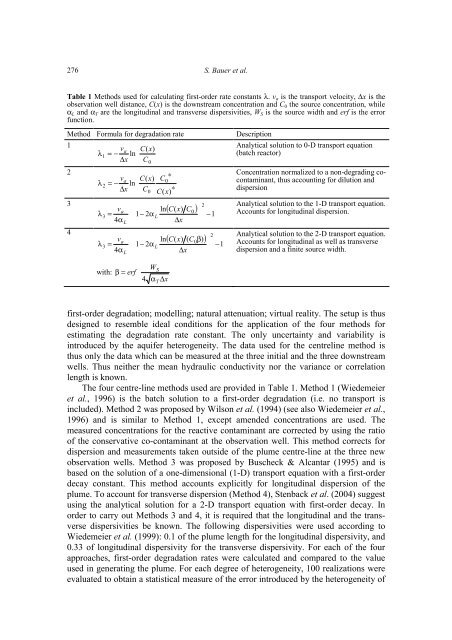Applied numerical modeling of saturated / unsaturated flow and ...
Applied numerical modeling of saturated / unsaturated flow and ...
Applied numerical modeling of saturated / unsaturated flow and ...
Create successful ePaper yourself
Turn your PDF publications into a flip-book with our unique Google optimized e-Paper software.
276<br />
S. Bauer et al.<br />
Table 1 Methods used for calculating first-order rate constants λ. va is the transport velocity, ∆x is the<br />
observation well distance, C(x) is the downstream concentration <strong>and</strong> C0 the source concentration, while<br />
αL <strong>and</strong> αT are the longitudinal <strong>and</strong> transverse dispersivities, WS is the source width <strong>and</strong> erf is the error<br />
function.<br />
Method Formula for degradation rate Description<br />
1<br />
va � C(<br />
x)<br />
�<br />
λ1<br />
= − ln� �<br />
∆x<br />
� �<br />
� C0<br />
�<br />
Analytical solution to 0-D transport equation<br />
(batch reactor)<br />
2<br />
v � ∗ �<br />
a � C(<br />
x)<br />
C0<br />
λ = −<br />
�<br />
2 ln<br />
∆x<br />
� C ∗ �<br />
� 0 C(<br />
x)<br />
�<br />
Concentration normalized to a non-degrading cocontaminant,<br />
thus accounting for dilution <strong>and</strong><br />
dispersion<br />
3<br />
�<br />
2<br />
v<br />
( ) �<br />
a ��<br />
ln C(<br />
x)<br />
C0<br />
�<br />
λ = � − α<br />
� −1�<br />
3 1 2 L<br />
4α<br />
�<br />
�<br />
L ��<br />
∆x<br />
� �<br />
Analytical solution to the 1-D transport equation.<br />
Accounts for longitudinal dispersion.<br />
4<br />
�<br />
2<br />
v<br />
( ) �<br />
a ��<br />
ln C(<br />
x)<br />
( C0β)<br />
�<br />
λ = � − α<br />
� −1�<br />
3 1 2 L<br />
4α<br />
�<br />
�<br />
L ��<br />
∆x<br />
� �<br />
Analytical solution to the 2-D transport equation.<br />
Accounts for longitudinal as well as transverse<br />
dispersion <strong>and</strong> a finite source width.<br />
� �<br />
with: � WS<br />
β = erf �<br />
� �<br />
� 4 αT<br />
∆x<br />
�<br />
first-order degradation; modelling; natural attenuation; virtual reality. The setup is thus<br />
designed to resemble ideal conditions for the application <strong>of</strong> the four methods for<br />
estimating the degradation rate constant. The only uncertainty <strong>and</strong> variability is<br />
introduced by the aquifer heterogeneity. The data used for the centreline method is<br />
thus only the data which can be measured at the three initial <strong>and</strong> the three downstream<br />
wells. Thus neither the mean hydraulic conductivity nor the variance or correlation<br />
length is known.<br />
The four centre-line methods used are provided in Table 1. Method 1 (Wiedemeier<br />
et al., 1996) is the batch solution to a first-order degradation (i.e. no transport is<br />
included). Method 2 was proposed by Wilson et al. (1994) (see also Wiedemeier et al.,<br />
1996) <strong>and</strong> is similar to Method 1, except amended concentrations are used. The<br />
measured concentrations for the reactive contaminant are corrected by using the ratio<br />
<strong>of</strong> the conservative co-contaminant at the observation well. This method corrects for<br />
dispersion <strong>and</strong> measurements taken outside <strong>of</strong> the plume centre-line at the three new<br />
observation wells. Method 3 was proposed by Buscheck & Alcantar (1995) <strong>and</strong> is<br />
based on the solution <strong>of</strong> a one-dimensional (1-D) transport equation with a first-order<br />
decay constant. This method accounts explicitly for longitudinal dispersion <strong>of</strong> the<br />
plume. To account for transverse dispersion (Method 4), Stenback et al. (2004) suggest<br />
using the analytical solution for a 2-D transport equation with first-order decay. In<br />
order to carry out Methods 3 <strong>and</strong> 4, it is required that the longitudinal <strong>and</strong> the transverse<br />
dispersivities be known. The following dispersivities were used according to<br />
Wiedemeier et al. (1999): 0.1 <strong>of</strong> the plume length for the longitudinal dispersivity, <strong>and</strong><br />
0.33 <strong>of</strong> longitudinal dispersivity for the transverse dispersivity. For each <strong>of</strong> the four<br />
approaches, first-order degradation rates were calculated <strong>and</strong> compared to the value<br />
used in generating the plume. For each degree <strong>of</strong> heterogeneity, 100 realizations were<br />
evaluated to obtain a statistical measure <strong>of</strong> the error introduced by the heterogeneity <strong>of</strong>

















